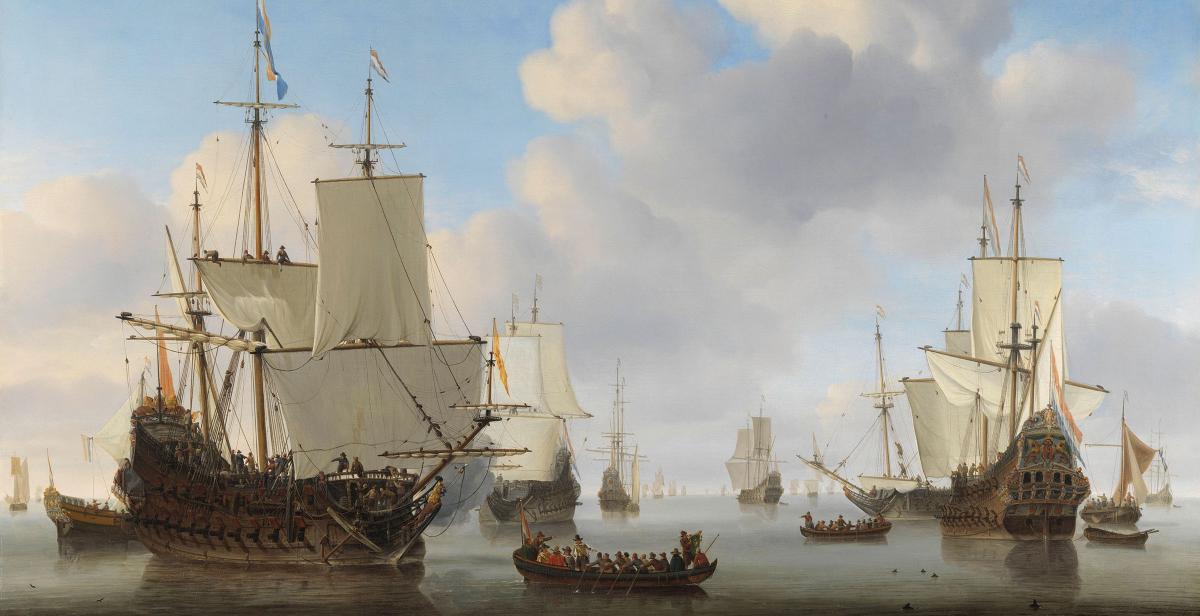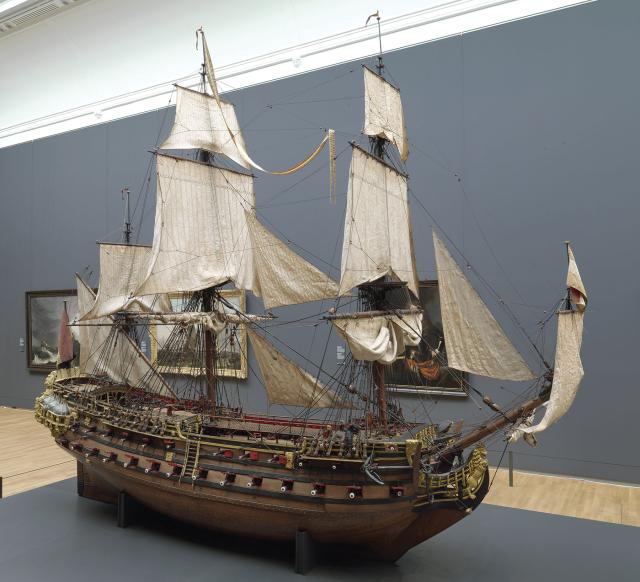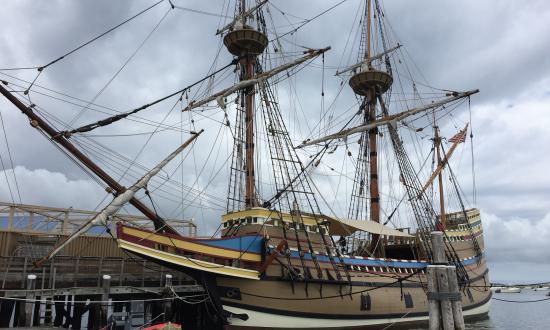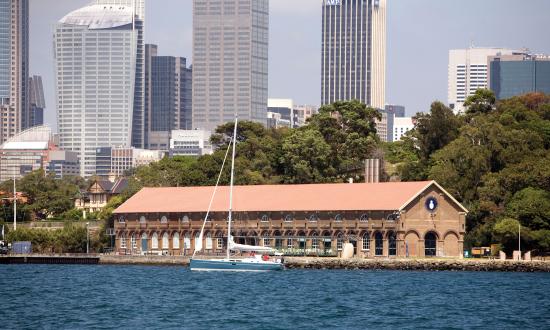Every year millions of people visit the Rijksmuseum in Amsterdam, drawn by its superb collection of Dutch masterpieces. Visitors with a maritime interest may be surprised to discover that the Rijksmuseum also has excellent exhibits of art and artifacts from Holland’s Golden Age of Sail.
The first indication of this comes in the large stained-glass windows that guests pass by on their way to the Hall of Honor. In one window stands a sturdy navigator, a sextant in his right hand. The Hall of Honor displays the best known and most popular works in the vast collection. Sharing this distinguished gallery with Rembrandt’s Night Watch and Vermeer’s Milkmaid is Willem van de Velde the Younger’s masterful Dutch Ships in a Calm Sea (1665). Van de Velde has captured the essence and detail of ship and crew and surrounded them with a gorgeous blue sky and flat sea.
Because much of Holland’s history derives from its connection with the sea, visitors will encounter maritime paintings throughout the museum. However, the greatest concentrations of maritime art and artifacts reside in gallery 2.15 and in the navy models collection in gallery 0.13.
Gallery 2.15 could be named for Admiral Michiel de Ruyter (active 1637–76), who ranks among the Netherlands’ most distinguished naval leaders. (See “Four Days in 1666,” June, p. 8.) Above the room’s entrance hangs one of the Netherlands’ most significant war trophies: the coat of arms of Charles II, King of England, with its lion rampant and prancing unicorn. This carving once graced the stern of the Royal Charles, flagship of the English fleet. During the Second Anglo-Dutch War (1665–67), de Ruyter led the Dutch fleet up the Medway River in a successful attack on the Royal Navy. De Ruyter’s forces captured the Royal Charles and towed their prize back to Holland.
An impressive formal portrait of Admiral de Ruyter hangs in the gallery. Close by it are a splendid gold and ceramic goblet celebrating his victory in the Medway raid and a gold medal presented to him by the Admiralty of Amsterdam in 1657.
In the center of the gallery is a model of the 74-gun ship William Rex, built in 1698 by dockyard craftsmen. Its size (13½ feet long by 14¾ feet high) and exquisite detail demand a visitor’s attention. Surrounding the ship on the gallery walls are more masterpieces of maritime art. Several depict the devastation of de Ruyter’s raid on the Medway. A large (5½ feet by 9½ feet) pen-and-ink drawing by Willem van de Velde the Elder (1657) depicts more than 60 ships fighting the Battle of Terheide (1653) in the First Anglo-Dutch War. A visitor could easily spend an hour appreciating the historic detail and luminosity of these works.
Two floors below, gallery 0.13 overflows with ship models, half hulls, and nautical artifacts. Immediately on entering this atmospherically lit gallery, visitors encounter an armada of some 30 model ships and small craft from the 17th through 19th centuries: warships, merchant vessels, fishing boats, galleys, paddlewheel steamers, and more. The presentation is majestic, and the models demonstrate the best work of professional shipwrights.
Complementing the ships is a large collection of half hulls. Near them are exhibit cases full of models of Dutch maritime equipment, from cannons and capstans to a ship’s galley and a bread chest. There are also full-size artifacts such as anchors, pistols, and swords.
An unexpected treat is a large cutaway model of a sailing vessel into which are projected moving images of sailors. Visitors can watch as crewmen holystone the deck, mend sails, and practice their gunnery with a cannon. The imagery even extends to milk goats in cribs belowdecks.
The Rijksmuseum is a delight for both art lovers and maritime history fans. English speakers will appreciate that interpretive labels offer English in addition to Dutch. The museum was temporarily closed because of COVID-19, but reopened 9 June. Museum tickets must be booked in advance. Check the website for the most up to date COVID-19 visitor protocols.







